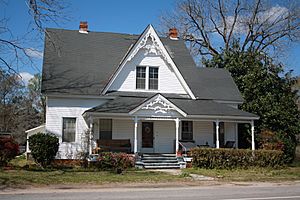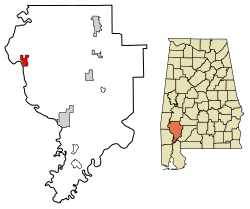Coffeeville, Alabama facts for kids
Quick facts for kids
Coffeeville, Alabama
|
|
|---|---|

Victorian house on Alabama State Route 69 in Coffeeville
|
|

Location of Coffeeville in Clarke County, Alabama.
|
|
| Country | United States |
| State | Alabama |
| County | Clarke |
| Area | |
| • Total | 4.52 sq mi (11.71 km2) |
| • Land | 4.52 sq mi (11.71 km2) |
| • Water | 0.00 sq mi (0.00 km2) |
| Elevation | 174 ft (53 m) |
| Population
(2020)
|
|
| • Total | 263 |
| • Density | 58.19/sq mi (22.47/km2) |
| Time zone | UTC-6 (Central (CST)) |
| • Summer (DST) | UTC-5 (CDT) |
| ZIP code |
36524
|
| Area code(s) | 251 |
| FIPS code | 01-16264 |
| GNIS feature ID | 116356 |
| Website | https://www.townofcoffeeville.org/ |
Coffeeville is a small town located in Clarke County, Alabama, in the United States. In 2020, about 263 people lived there.
Contents
History of Coffeeville
The town of Coffeeville was officially started in 1817.
In 1892, Coffeeville was the location of a serious conflict. This event was about money and fairness between different groups of people. It later became known as the Mitcham War.
Geography of Coffeeville
Coffeeville is in the northwestern part of Clarke County. It sits on high ground near the Tombigbee River.
The town covers a total area of about 11.7 square kilometers (4.5 square miles). All of this area is land.
People of Coffeeville
| Historical population | |||
|---|---|---|---|
| Census | Pop. | %± | |
| 1870 | 280 | — | |
| 1880 | 104 | −62.9% | |
| 1940 | 250 | — | |
| 1950 | 211 | −15.6% | |
| 1960 | 250 | 18.5% | |
| 1970 | 441 | 76.4% | |
| 1980 | 448 | 1.6% | |
| 1990 | 431 | −3.8% | |
| 2000 | 360 | −16.5% | |
| 2010 | 352 | −2.2% | |
| 2020 | 263 | −25.3% | |
| U.S. Decennial Census 2013 Estimate |
|||
In the year 2000, there were 360 people living in Coffeeville. These people lived in 165 different homes. About 97 of these were family homes.
The town had about 79.7 people per square mile. This is called the population density.
Most people in the town were White (61.11%). The rest were Black or African American (38.89%).
About 22.4% of homes had children under 18 living there. Many homes (40.6%) were married couples. Some homes (13.9%) had a female head of household with no husband.
The average age of people in Coffeeville was 42 years old. About 23.9% of the population was under 18. About 20.8% were 65 years or older.
In 2000, the average income for a home in Coffeeville was $19,545. For families, the average income was $33,125. About 25.6% of all people in the town lived below the poverty line. This means they had very low incomes.
Famous People from Coffeeville
- Tom Long, a professional baseball player.
- Ashton Shepherd, a singer.
- Willie J. Slater, a football coach for the Tuskegee University Golden Tigers.
See also
 In Spanish: Coffeeville (Alabama) para niños
In Spanish: Coffeeville (Alabama) para niños

